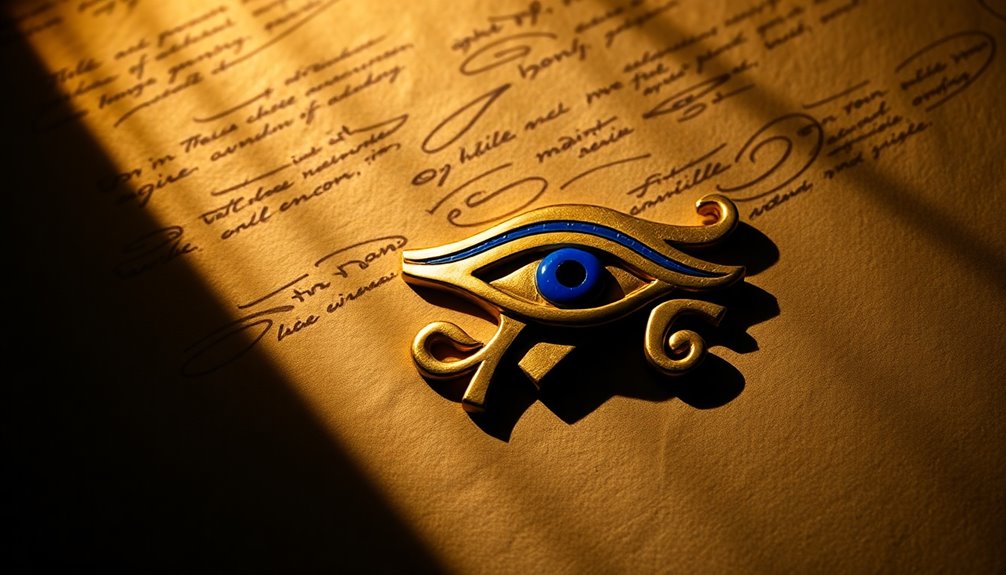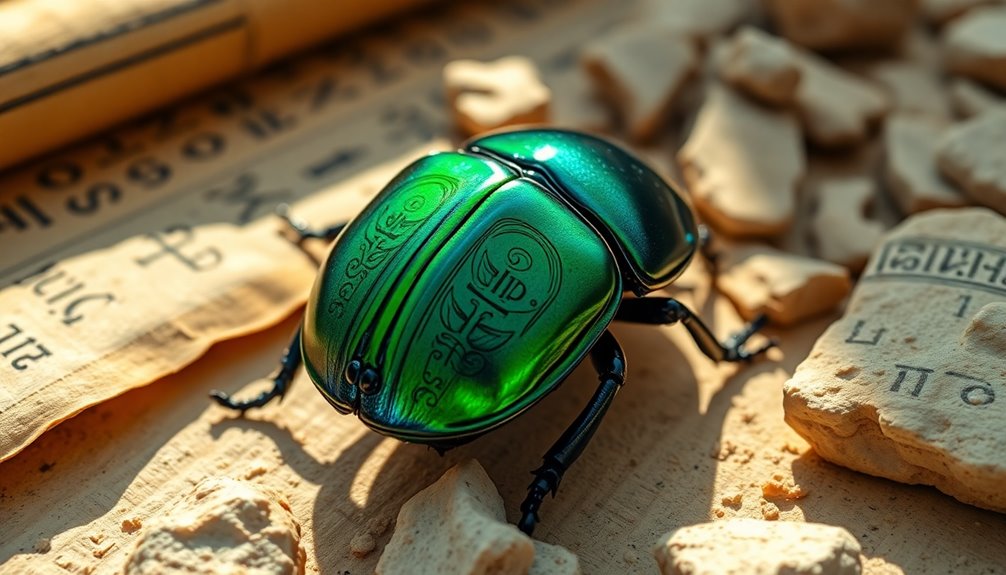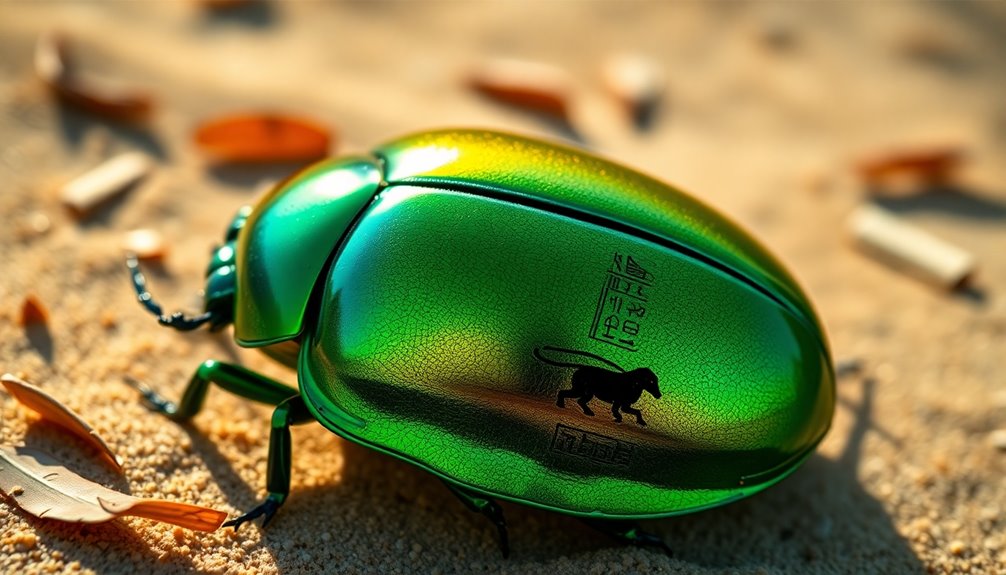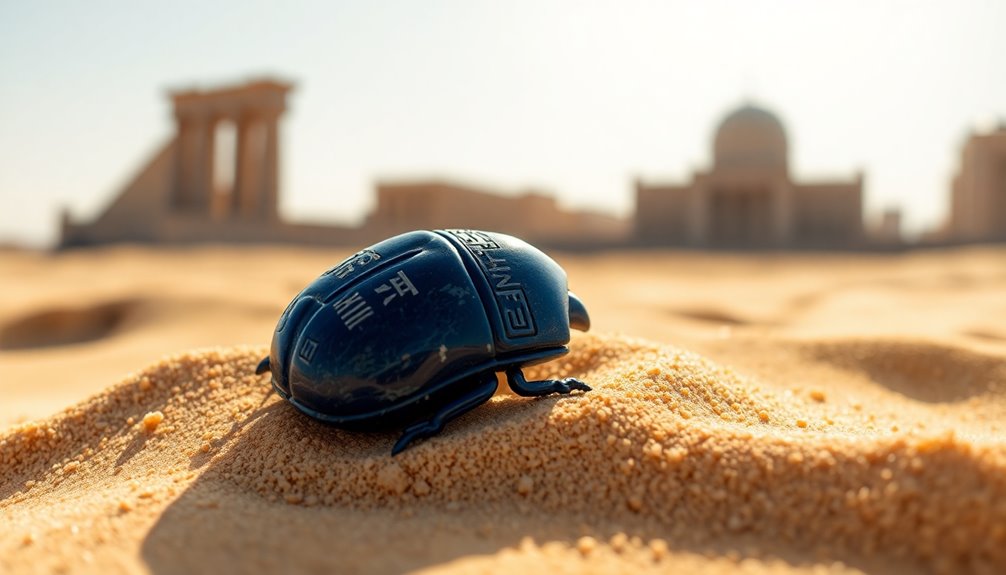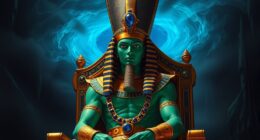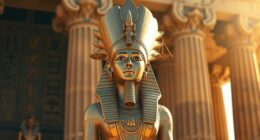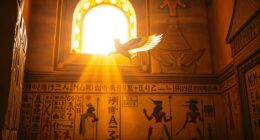The Ankh tattoo is a meaningful symbol of life, death, and spiritual empowerment. Originating in ancient Egypt, it represents immortality and serves as a connection between the earthly and divine. This powerful icon encourages you to embrace life's cycle, highlighting rebirth and new beginnings. The Ankh also embodies personal strength, often acting as a talisman during spiritual journeys. With various designs and personalization options, it remains popular in modern tattoo culture, appealing to those seeking deeper connections to heritage and spirituality. Stick around, and you'll uncover more fascinating insights about this timeless symbol.
Key Takeaways
- The Ankh symbolizes life, immortality, and the connection between earthly existence and the afterlife, making it a powerful tattoo choice.
- Its design represents death and rebirth, encouraging individuals to embrace the cyclical nature of life.
- The Ankh serves as a talisman for spiritual awakening, empowerment, and protection during personal journeys.
- Modern interpretations of the Ankh in tattoos often combine it with other symbols, enhancing its meaning and personal significance.
- Across cultures, the Ankh retains its status as a symbol of eternal life, resonating with themes of heritage and spiritual connection.
Historical Origins of the Ankh
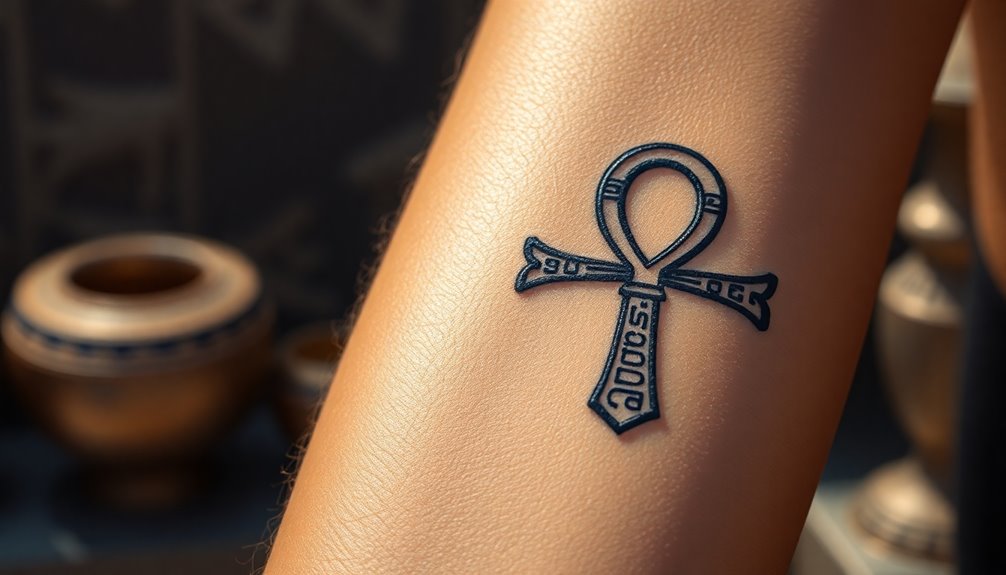
Since ancient times, the Ankh has symbolized life and immortality, originating in Egypt where it was revered as the "key of life." This unique symbol, resembling a cross with a loop at the top, captures the essence of the eternal soul and its journey beyond the physical domain.
The origins of the Ankh are deeply rooted in ancient Egyptian mythology, where it represented not just life, but also the power held by deities.
You'll often find the Ankh depicted in various forms of Egyptian art and hieroglyphics, frequently held by gods and goddesses like Isis and Osiris. This association highlights the Ankh's significance in the context of life and death, emphasizing its role as a powerful emblem of protection for the soul in the afterlife.
It served as an amulet for the deceased, ensuring safe passage and immortality.
Derived from the Egyptian word for "life," the Ankh's impact extends beyond its origins, influencing various cultural and spiritual movements throughout history.
Symbolism of Life and Death
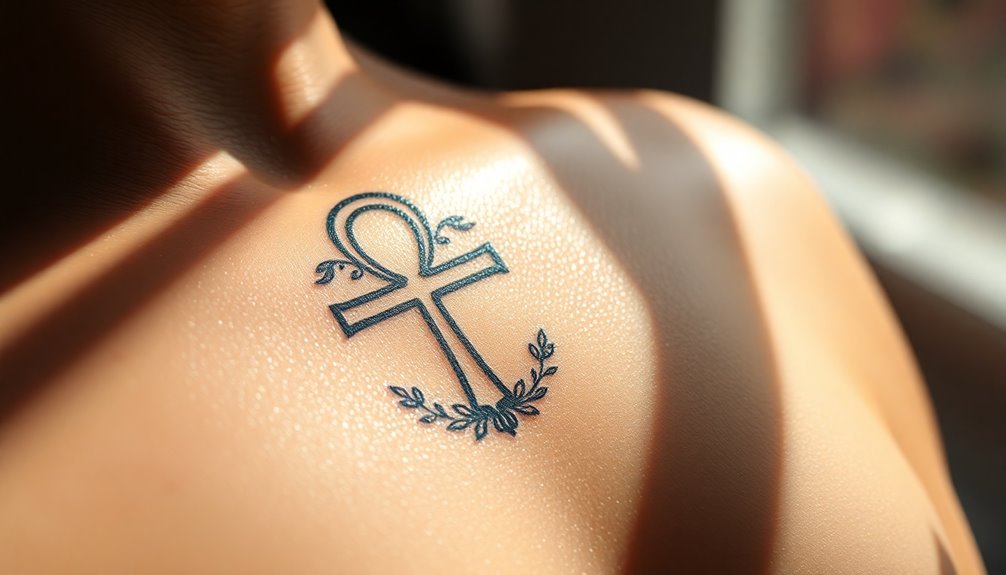
The Ankh tattoo represents a powerful connection between life and death, emphasizing the significance of eternal life.
It embodies the concepts of death and rebirth, reminding you that every ending is also a new beginning.
Eternal Life Significance
Ankh tattoos often carry profound meaning, especially when it comes to the symbolism of life and death. As an ancient Egyptian symbol, the Ankh represents eternal life, reminding you of the soul's journey beyond the physical dimension. Its unique design—a loop atop a cross—signifies the connection between earthly existence and the promise of immortality.
The Ankh's significance in funerary practices underscores its role as a powerful reminder of life and the afterlife. It served as an amulet, protecting the soul and ensuring a safe passage to continued existence. This symbolism resonates deeply in modern interpretations, encouraging you to embrace the cyclical nature of life.
| Symbolism | Meaning |
|---|---|
| Loop at the top | Eternal life |
| Cross | Earthly existence |
| Used by gods | Power over life and death |
| Funerary amulet | Protection and immortality |
Death and Rebirth Concepts
Embracing the concepts of death and rebirth through the Ankh tattoo can profoundly impact your perspective on life. The Ankh symbol captures the essence of the cyclical nature of existence, reminding you that life isn't just a linear journey but a continuous flow of experiences.
In ancient Egyptian mythology, the Ankh represented the profound connection between life and the afterlife, often seen in the hands of deities who held the power of resurrection and immortality.
This powerful symbol emphasizes the importance of acknowledging both life's moments and the inevitable changes we all face. The loop at the top signifies eternal life, while the cross represents earthly existence, beautifully illustrating the duality of life and death.
By wearing an Ankh tattoo, you invite a spiritual awakening, embracing the death and rebirth concepts that promote personal growth. Understanding the cyclical nature of existence is essential for appreciating the transformative power of this symbol.
This tattoo serves as a reminder that every ending can lead to a new beginning, encouraging resilience and empowerment. As you reflect on the Ankh's significance, you cultivate a deeper understanding of your journey and the endless possibilities that lie ahead.
Spiritual Significance and Empowerment
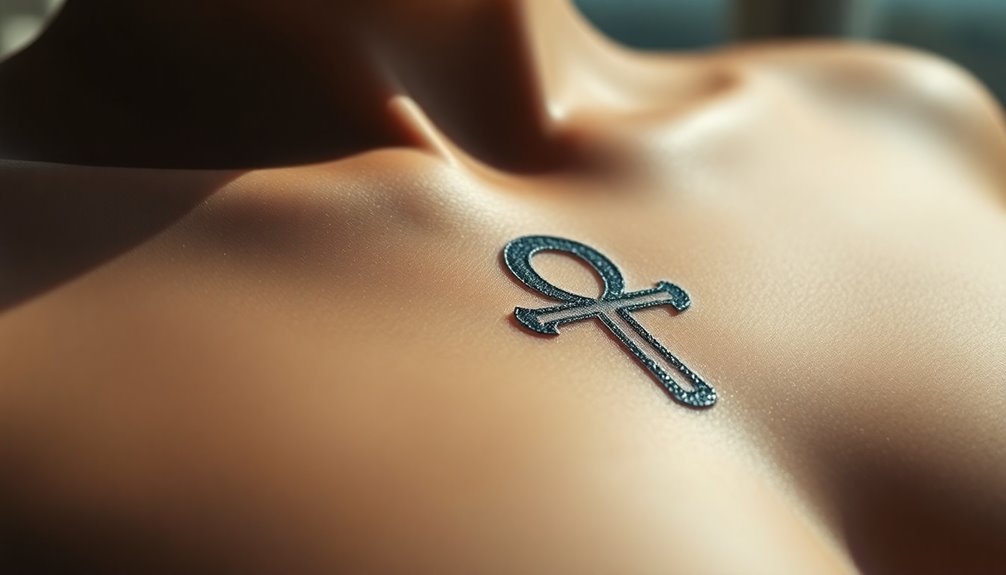
Rooted in ancient symbolism, the Ankh represents not just life but also spiritual awakening, making it a powerful emblem for those on a journey of self-discovery.
The Ankh Tattoo Meaning extends beyond mere aesthetics; it embodies the spiritual significance of eternal life and the soul's journey beyond physical existence. This symbol serves as a conduit for divine energy, empowering you to explore higher consciousness and fostering spiritual growth.
In ancient Egyptian culture, the Ankh was associated with deities like Isis and Osiris, providing protection and guidance throughout spiritual journeys. It reinforces the balance between masculine and feminine energies, promoting harmony within yourself and the universe.
As you embrace the Ankh, you tap into ancient wisdom that encourages a deeper connection to nature and the cyclical nature of life and death.
Many modern spiritual practices incorporate the Ankh as a talisman for empowerment. By wearing this symbol, you remind yourself of your innate strength and potential for transformation.
The Ankh encourages you to honor your spiritual path, fostering a sense of unity with the greater cosmos and the timeless cycle of existence.
The Ankh in Ancient Egyptian Culture
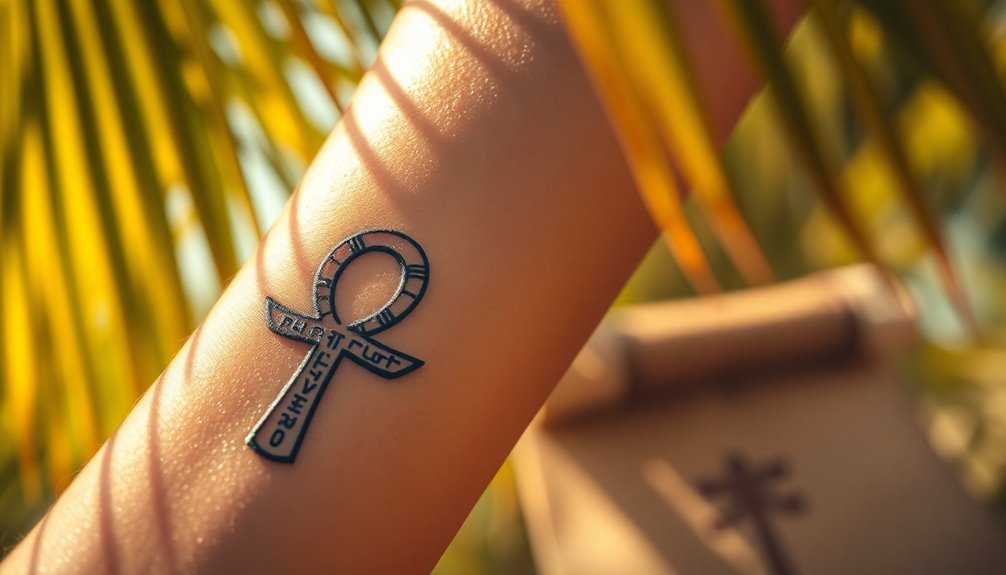
The Ankh embodied divine authority in ancient Egyptian culture, often seen in the hands of gods and goddesses as a symbol of their control over life and death.
Its significance in funerary rituals highlights its role in guiding souls to the afterlife, ensuring protection and continuity.
You can also find the Ankh depicted in various forms of art, reinforcing its importance as a life-giving symbol throughout Egyptian history.
Symbol of Divine Authority
In ancient Egyptian culture, the Ankh symbolizes divine authority, often seen held by deities and pharaohs. This powerful symbol serves as a connection between life and the afterlife, embodying profound meanings related to existence and spirituality.
When you explore the Ankh Tattoo Meaning: The Secret Behind This Timeless Symbol, you'll find that it reflects the ancient Egyptians' deep belief in the continuity of life after death.
The goddess Isis, frequently associated with the Ankh, illustrates her protective powers and essential role in resurrecting Osiris, further emphasizing the symbol's importance in spiritual authority. Pharaohs carried the Ankh as a representation of their divine right to rule, showcasing their link to the gods and their ability to grant life or guarantee continuity in the afterlife.
Additionally, the Ankh appears extensively in Egyptian art and hieroglyphics, reinforcing its status as a timeless symbol. Its artistic styles vary, but the essence remains unchanged—a reminder of the divine authority that governs life and the eternal journey between the mortal domain and the divine.
Embracing an Ankh tattoo can connect you to this rich tapestry of ancient beliefs and spiritual significance.
Funerary Ritual Significance
Ankh symbols adorned ancient Egyptian tombs, reflecting their profound beliefs about life after death.
These ancient artifacts were central to funerary rituals, embodying the Ankh meaning as a representation of eternal life. The Ankh symbolized the connection between the mortal sphere and the divine, acting as a bridge for the departed souls.
During these rituals, gods were often depicted holding the Ankh, signifying their control over life and death. The promise of resurrection for the deceased was a crucial aspect of these ceremonies.
To emphasize this significance, consider these key elements:
- Amulets shaped like the Ankh were placed with the dead for protection.
- Priests invoked the Ankh's powers to guide spirits safely to the afterlife.
- The Ankh appeared prominently in tomb paintings, showcasing its importance in ancient Egyptian art.
- Deities like Osiris and Isis were linked to the Ankh, underscoring themes of rebirth.
Depictions in Art
Ancient Egyptian art is rich with symbolism, and the Ankh stands out as a prominent motif that captures the essence of life and death. This ancient symbol represents eternal life, and you can find it frequently depicted in various artistic styles. Often shown in the hands of deities and pharaohs, the Ankh signifies their powerful control over life and death.
In tomb paintings and hieroglyphics, its presence underscores the beliefs and connection to the afterlife. The goddess Isis, known for her powers of resurrection, is commonly associated with the Ankh, emphasizing its protective qualities for the deceased.
Here's a table illustrating the significance of the Ankh in ancient Egyptian art:
| Depiction | Significance | Associated Deities |
|---|---|---|
| Held by Pharaohs | Control over life and death | Osiris |
| Near the mouth | Life-giving power and breath | Isis |
| In tomb paintings | Immortality and rebirth | Anubis |
| Hieroglyphics | Connection to divine providence | Ra |
The Ankh's representation in art reinforces its role as a powerful symbol of immortality and divine connection throughout ancient Egyptian culture.
Modern Interpretations and Popularity

Symbolism has evolved considerably in contemporary culture, and the Ankh tattoo stands out as a powerful emblem of eternal life and personal empowerment. Its rich historical significance resonates with a diverse audience, reflecting deep connections to cultural and religious heritage.
Modern interpretations of the Ankh tattoo embrace unique artistic styles, allowing for personal expression and creativity. You might find these popular elements:
- Traditional hieroglyphic designs that honor its ancient roots
- Minimalist renditions that offer a sleek, modern look
- Combinations with symbols like the Eye of Horus for added depth
- Floral elements that symbolize growth and beauty
As a representation of life, death, and rebirth, the Ankh has become a favored choice for those on spiritual journeys. Its versatility allows for various placements on the body, with common spots including the wrist, forearm, and shoulder.
This adaptability not only enhances visibility but also personal significance, making the Ankh tattoo a meaningful piece of body art. Whether you're drawn to its historical background or its modern-day interpretations, the Ankh remains a compelling symbol of empowerment and connection to ancient wisdom.
Design Variations and Personalization
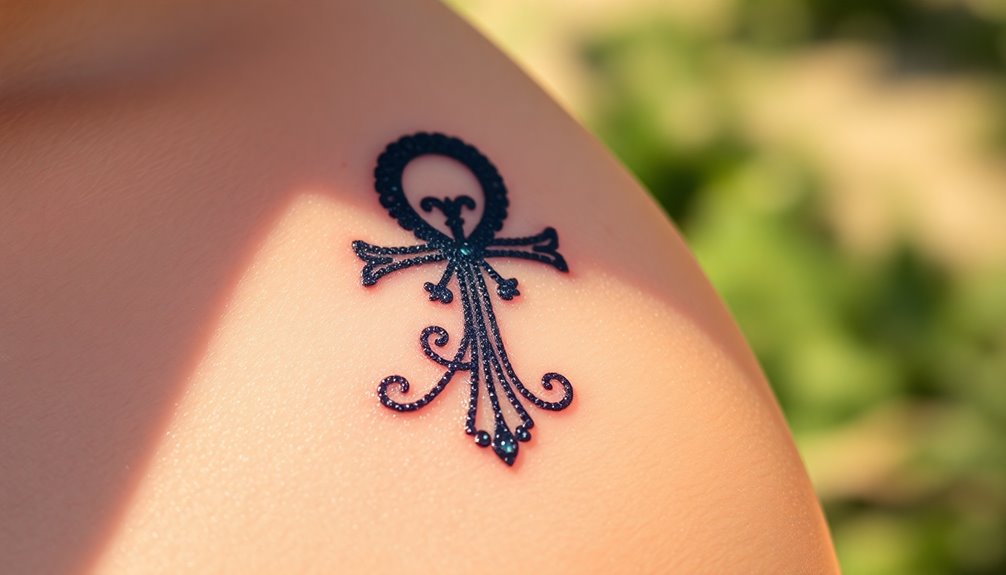
When it comes to designing an Ankh tattoo, you'll find a wealth of options that cater to your personal style and preferences. The beauty of the Ankh lies in its design variations; you can choose from traditional, minimalist, or tribal styles, allowing for unique artistic expression.
Customization options further enhance your tattoo's personal significance. Consider incorporating elements like lotus flowers, scarabs, or hieroglyphs to deepen its meaning.
Your color choices play an essential role as well, ranging from classic black ink to vibrant hues like gold, blue, and red. These colors can greatly impact the overall aesthetic of the design.
Thanks to the symmetrical shape of the Ankh, it's versatile for placement on various body parts, such as your wrists, forearms, or shoulders—depending on your visibility preference.
Size considerations are also important; smaller designs often require simpler details to maintain clarity, while larger pieces can accommodate intricate patterns and additional symbols.
The Ankh's Influence Across Cultures

Throughout history, the Ankh has transcended its origins in ancient Egypt to become a powerful symbol across various cultures. This profound emblem symbolizes not only eternal life but also the interconnectedness of life, death, and rebirth.
You'll find its influence in numerous cultural contexts, reflecting a rich tapestry of spiritual beliefs and practices.
Consider how the Ankh:
- Represents eternal life and resurrection in Christianity as the "crux ansata."
- Serves as a personal talisman in Kemiteism, balancing feminine and masculine energies.
- Acts as a symbol of protection against evil in contemporary art and fashion.
- Embodies cultural heritage, resonating with those who cherish ancient wisdom.
As you explore the Ankh's significance, you'll see it embodies resilience and empowerment.
It's no wonder that this timeless symbol remains popular in tattoo culture, often personalized with other motifs to deepen its meaning.
Each Ankh tattoo you encounter tells a story of connection to a rich heritage and a profound commitment to spiritual exploration.
Embrace the Ankh, and let it guide you through your own journey of discovery.
Frequently Asked Questions
What Is the True Meaning of the Ankh Symbol?
The true meaning of the Ankh symbol lies in its representation of life, death, and the eternal cycle of existence.
You'll notice it symbolizes the union of opposites, particularly male and female energies. Originally from ancient Egypt, it conveyed power over life and death, often seen in art and hieroglyphics.
Today, it remains a potent talisman for protection and spiritual awakening, resonating with themes of hope and immortality.
What Does the Bible Say About Ankh?
The Bible doesn't mention the Ankh, as it's primarily an ancient Egyptian symbol.
However, you might find its themes of eternal life resonating with biblical concepts of resurrection and immortality. Passages like John 3:16 and 1 Corinthians 15:51-52 reflect similar ideas.
In early Christian art, the Ankh occasionally appears, symbolizing hope and continuity, paralleling core Christian beliefs about the afterlife and the soul's journey.
What Does the Ankh Represent in a Tattoo?
When you wear an Ankh tattoo, you're embracing a powerful symbol of life and immortality.
The loop at the top signifies eternal life, while the cross connects you to the material world.
This tattoo can represent your personal journey, resilience, and spiritual beliefs.
It's not just ink; it's a reminder of your connection to ancient wisdom and the cycles of existence, offering you empowerment and guidance as you navigate your path.
What Is the Secret of the Ankh?
The secret of the Ankh lies in its profound symbolism.
You see, it represents life, death, and the eternal cycle of existence. When you look at its unique shape, you recognize the union of male and female energies.
It signifies not just earthly life but also a connection to the afterlife. This ancient emblem embodies spiritual empowerment, reminding you of the quest for understanding and protection as you navigate life's journey.
Conclusion
In the vibrant clash of ancient and modern, the ankh transcends time, embodying both the fragility of life and the strength of immortality. You're not just wearing a tattoo; you're embracing a legacy that whispers of resurrection while boldly asserting your individuality. As you explore its rich meanings, remember that every ankh tells a story—yours. So, whether it's a symbol of faith or a statement of style, let it empower you in your own unique journey.




